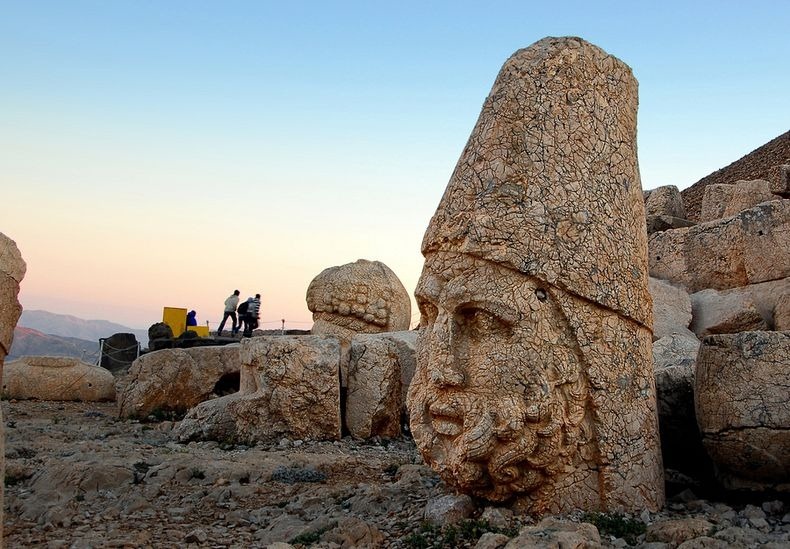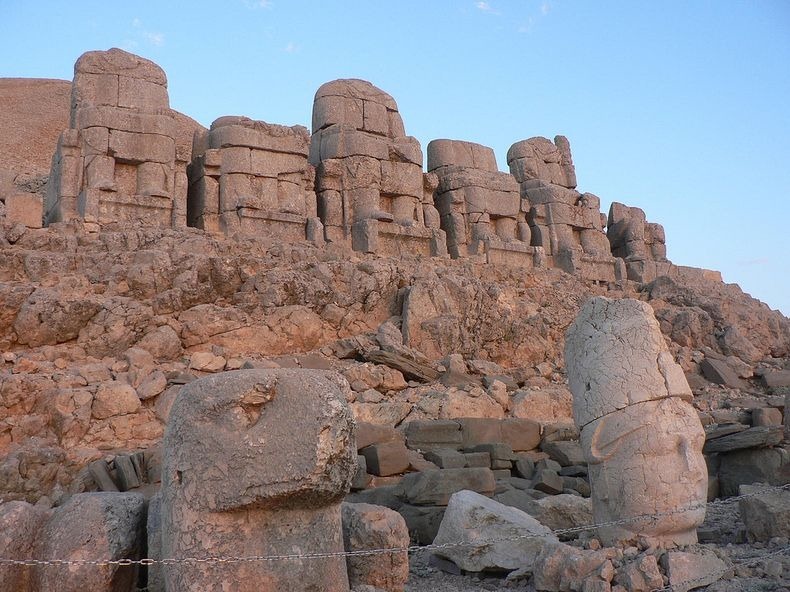Ruins of the Commagene Kingdom at Mount Nemrut
Mount Nemrut also called Mount Nemrud is one of the most
interesting tourist attractions of Turkey. At the summit of this
approximately 2000 meter mountain lies the ruins of the ancient
Commagene Kingdom which was at its height of power during the 1st
century B.C. The mountain lies 40 km north of Kahta, near Adıyaman.
Mount Nemrut is part of the Taurus mountain range, above the Firat
(Euphrates)River valley and a grassy plateau, within the boundaries of
Karadut village near Kahta. This spectacular structure is made
of large slabs of rock to form a pyramid-like configuration. The east
and west terraces of this mound are open-air temples. On these terraces
are immense statues of lions, eagles, five gigantic god statues, four
male and one female, most of which are amazingly well preserved.
The Commagene, which means the “community of genes”, was founded as an independent kingdom by Mithridates Kallinikos I at the beginning of the 1st Century BC after a civil war which terminated the Seleucid line. The kingdom raised to prominence during the reign of Antiochus Epiphanes (62-32 BC), the son of Mithridates Kallinikos.

Photo credit
In 62 BC, King Antiochus I Theos of Commagene built on the mountain top a tomb-sanctuary flanked by huge statues of himself, two lions, two eagles and various Greek, Armenian, and Iranian gods, such as Hercules-Vahagn, Zeus-Aramazd or Oromasdes (associated with the Iranian god Ahura Mazda), Tyche, and Apollo-Mithras. These statues were once seated, with names of each god inscribed on them. The heads of the statues have at some stage been removed from their bodies, and they are now scattered throughout the site.
The pattern of damage to the heads suggests that they were deliberately damaged because of belief in iconoclasm. The statues have not been restored to their original positions. The site also preserves stone slabs with bas-relief figures that are thought to have formed a large frieze. These slabs display the ancestors of Antiochus, who included both Greek and Persians.
The same statues and ancestors found throughout the site can also be found on the tumulus at the site, which is 49 m (161 ft) tall and 152 m (499 ft) in diameter. The statues appear to have Greek-style facial features, but Persian clothing and hairstyling.
The western terrace contains a large slab with a lion, showing the arrangement of stars and the planets Jupiter, Mercury and Mars on 7 July 62 BC. This may be an indication of when construction began on this monument. The eastern portion is well preserved, being composed of several layers of rock, and a path following the base of the mountain is evidence of a walled passageway linking the eastern and western terraces. Possible uses for this site is thought to have included religious ceremonies, due to the astronomical and religious nature of the monument.
The best time to visit Mt. Nemrut is between May 15 and October 15. Touring vehicles can be hired from Adiyaman or Kahta district. One of the favorite activities here is watching the sunrise and sunset because of the magnificent views offered from the summit.

Photo credit

Photo credit

Photo credit

Photo credit

Photo credit

Photo credit

Photo credit

Photo credit

Photo credit
Source consulted: Amusing Planet
The Commagene, which means the “community of genes”, was founded as an independent kingdom by Mithridates Kallinikos I at the beginning of the 1st Century BC after a civil war which terminated the Seleucid line. The kingdom raised to prominence during the reign of Antiochus Epiphanes (62-32 BC), the son of Mithridates Kallinikos.

Photo credit
In 62 BC, King Antiochus I Theos of Commagene built on the mountain top a tomb-sanctuary flanked by huge statues of himself, two lions, two eagles and various Greek, Armenian, and Iranian gods, such as Hercules-Vahagn, Zeus-Aramazd or Oromasdes (associated with the Iranian god Ahura Mazda), Tyche, and Apollo-Mithras. These statues were once seated, with names of each god inscribed on them. The heads of the statues have at some stage been removed from their bodies, and they are now scattered throughout the site.
The pattern of damage to the heads suggests that they were deliberately damaged because of belief in iconoclasm. The statues have not been restored to their original positions. The site also preserves stone slabs with bas-relief figures that are thought to have formed a large frieze. These slabs display the ancestors of Antiochus, who included both Greek and Persians.
The same statues and ancestors found throughout the site can also be found on the tumulus at the site, which is 49 m (161 ft) tall and 152 m (499 ft) in diameter. The statues appear to have Greek-style facial features, but Persian clothing and hairstyling.
The western terrace contains a large slab with a lion, showing the arrangement of stars and the planets Jupiter, Mercury and Mars on 7 July 62 BC. This may be an indication of when construction began on this monument. The eastern portion is well preserved, being composed of several layers of rock, and a path following the base of the mountain is evidence of a walled passageway linking the eastern and western terraces. Possible uses for this site is thought to have included religious ceremonies, due to the astronomical and religious nature of the monument.
The best time to visit Mt. Nemrut is between May 15 and October 15. Touring vehicles can be hired from Adiyaman or Kahta district. One of the favorite activities here is watching the sunrise and sunset because of the magnificent views offered from the summit.

Photo credit

Photo credit

Photo credit

Photo credit

Photo credit

Photo credit

Photo credit

Photo credit

Photo credit
Source consulted: Amusing Planet